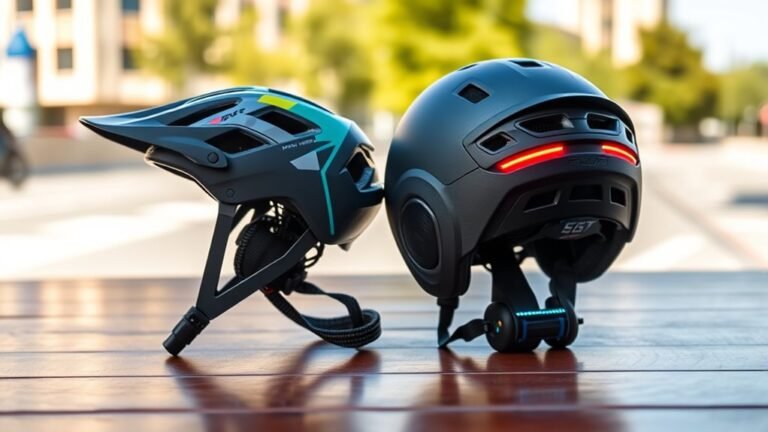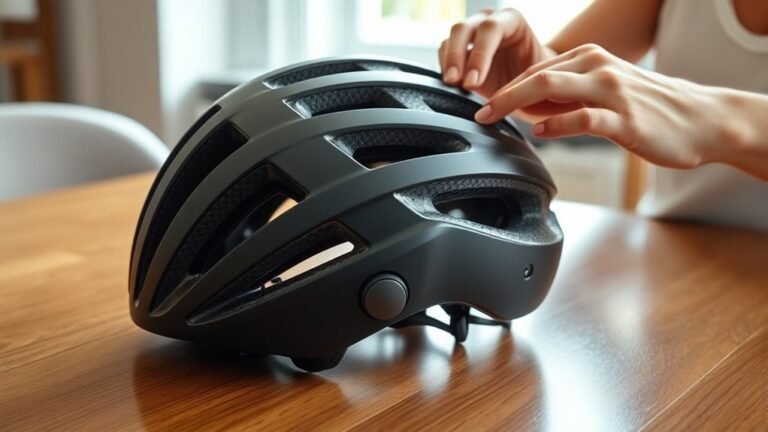Advanced Materials in E-Scooter Helmets
Advanced materials in e-scooter helmets drastically enhance safety and comfort for riders. Lightweight composites, such as bio-inspired materials and advanced foams, improve impact resistance without compromising wearability. Additionally, innovations like nanomaterials and smart textiles offer superior protection and real-time monitoring capabilities. These developments guarantee peak airflow and a secure fit while reducing injury risks upon impact. Explore the nuanced advancements in materials that are shaping the future of helmet design and rider safety.
The Importance of Helmet Safety in E-Scooter Riding
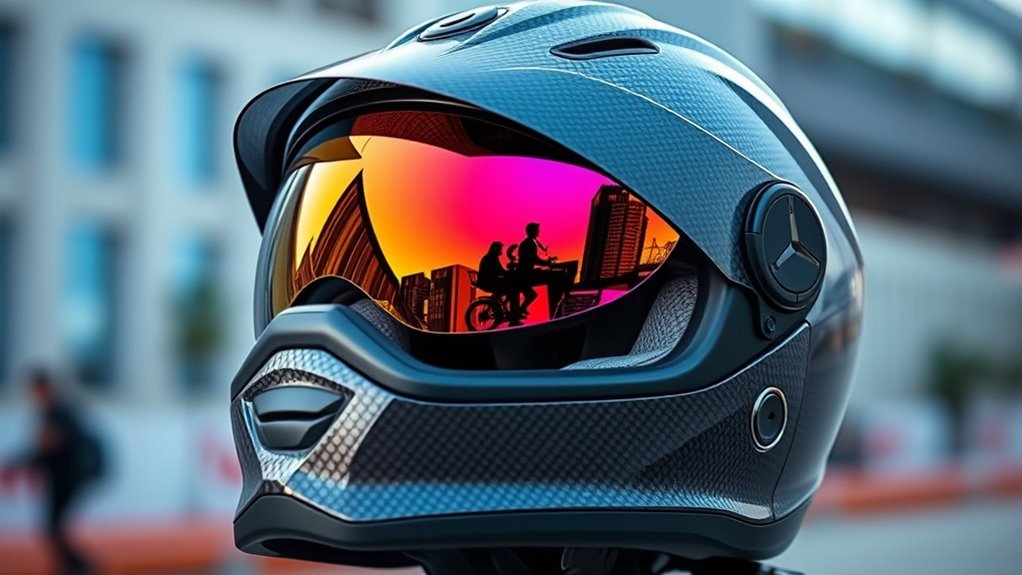
E-scooter riding has surged in popularity, but with this increase comes a heightened risk of accidents, making helmet safety critical. Compliance with helmet regulations is essential for fostering a safer riding environment. These regulations not only define minimum safety standards but also promote rider education on the importance of proper helmet use. You need to understand that a well-fitted helmet greatly reduces the risk of head injuries during unforeseen incidents. Riders must be educated about selecting helmets that meet safety certifications, ensuring that they’re protected while enjoying their freedom on the road. By prioritizing helmet safety and adhering to regulations, you can enhance your riding experience while minimizing potential hazards. Your safety should never be compromised for the sake of convenience.
Innovative Materials Enhancing Impact Resistance
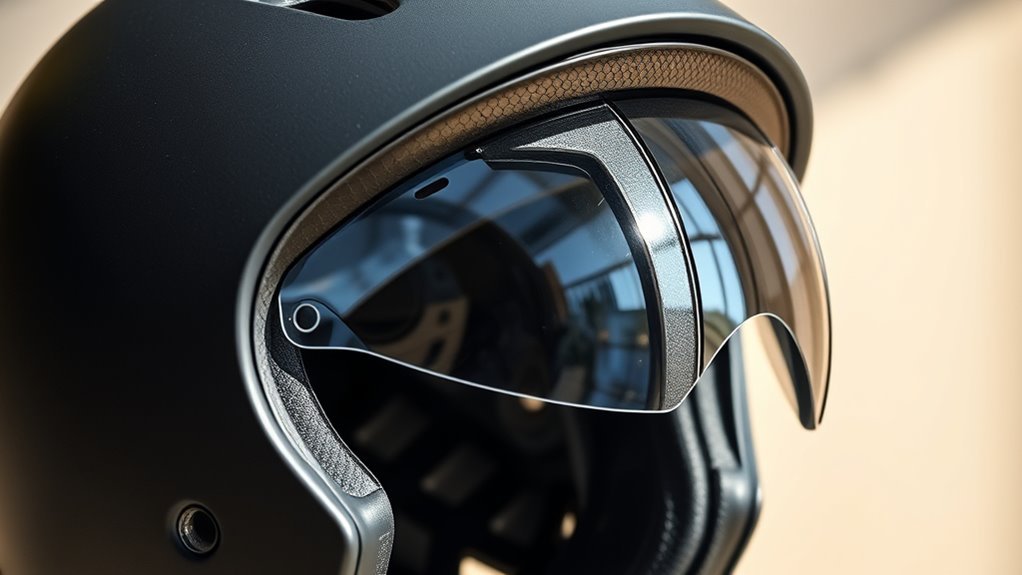
As advancements in helmet technology continue to evolve, innovative materials are playing an essential role in enhancing impact resistance. Bio-inspired composites, mimicking nature’s designs, offer superior energy absorption and structural integrity, ensuring your safety during rides. These materials often incorporate lightweight fibers, providing a robust defense against impacts without adding bulk. Meanwhile, nanomaterial applications, such as carbon nanotubes and graphene, greatly improve mechanical properties at a molecular level. They enhance the helmets’ strength and durability, allowing for thinner, more flexible designs that still meet safety standards. By integrating these cutting-edge materials, manufacturers are creating helmets that not only protect but also empower riders to embrace their freedom with confidence. Your safety should never be compromised, and these innovations are paving the way.
Lightweight Design: Balancing Protection and Comfort
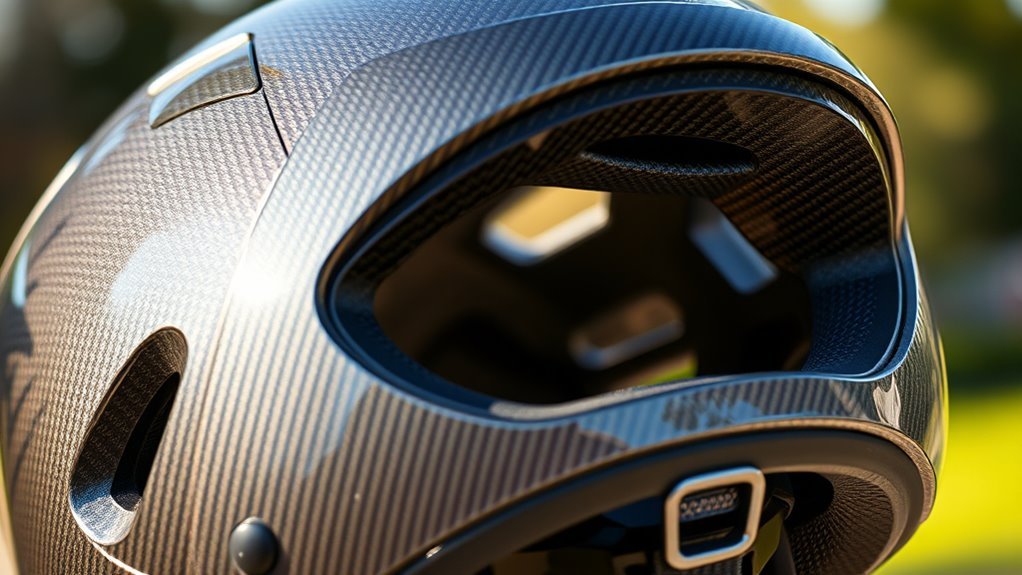
While achieving ideal protection is essential, the design of helmets must also prioritize comfort to encourage consistent use. A lightweight design not only enhances wearability but also aligns with user preferences for mobility. By integrating aerodynamic shapes, manufacturers can further reduce drag while guaranteeing maximum safety.
| Feature | Impact on Protection | Impact on Comfort |
|---|---|---|
| Aerodynamic Shapes | Enhances stability | Reduces wind resistance |
| Material Selection | Improves impact resistance | Lightweight feel |
| Ventilation Systems | Minimizes overheating | Increases airflow |
| Adjustable Fit Systems | Customizes security | Guarantees snugness |
Incorporating these elements creates a harmonious balance between safety and comfort, empowering users to embrace their freedom on e-scooters.
Advanced Cushioning Technologies for Improved Shock Absorption
To guarantee ideal safety, advanced cushioning technologies are essential for improving shock absorption in helmets. You’ll find that modern foam technologies, such as expanded polystyrene (EPS) and viscoelastic materials, play a key role in enhancing performance. These materials not only reduce the weight of the helmet but also provide superior impact dispersion, which minimizes injury risks during accidents. The effectiveness of these foams lies in their ability to deform upon impact, absorbing and distributing forces over a larger surface area. When you’re traversing urban environments on your e-scooter, knowing your helmet employs these advanced cushioning systems can give you peace of mind. Ultimately, investing in helmets with advanced cushioning technologies guarantees you maintain your freedom while prioritizing safety.
Future Trends in Helmet Material Development
Emerging trends in helmet material development are set to revolutionize safety standards in e-scooter helmets, particularly as researchers explore innovative composites and nanomaterials. You’ll likely see a shift towards sustainable sourcing, using materials that minimize environmental impact while enhancing performance. These advancements may include bio-based polymers and recycled fibers, ensuring that your helmet is not only protective but eco-friendly.
Additionally, the integration of smart textiles is on the horizon, allowing for real-time monitoring of conditions and potential impacts. Imagine a helmet that adjusts its properties based on external factors, providing personalized protection. As these materials evolve, you can expect a blend of safety, comfort, and sustainability, aligning with your desire for freedom without compromising on protection.
Frequently Asked Questions
How Do I Properly Fit an E-Scooter Helmet?
To properly fit an e-scooter helmet, start with proper sizing; measure your head circumference and select the corresponding helmet size. Once you have the right size, use adjustment techniques like the chin strap and padding to guarantee a snug fit. The helmet should sit level on your head, not tilted back. You shouldn’t feel any movement when you shake your head. A well-fitted helmet provides the freedom to ride safely and confidently.
What Are the Maintenance Tips for E-Scooter Helmets?
To keep your e-scooter helmet in top shape, think of it as your trusty shield. Use gentle cleaning techniques, like warm water and mild soap, to wipe off dirt and sweat. Avoid harsh chemicals that could degrade materials. For storage tips, keep it in a cool, dry place away from direct sunlight. Regularly check for any cracks or wear, ensuring your helmet remains a reliable companion on your rides.
Are There Age Restrictions for Wearing E-Scooter Helmets?
Yes, there are age guidelines for wearing e-scooter helmets, which vary by location. Many jurisdictions require riders under a certain age—often 18—to wear helmets for safety. These regulations aim to enhance rider safety, especially among younger users who may be more vulnerable in accidents. It’s essential for you to check local laws to guarantee compliance, as adhering to these age restrictions not only protects you but also promotes a culture of responsible riding.
Can I Use a Bike Helmet for E-Scooter Riding?
Yes, you can use a bike helmet for e-scooter riding, but it’s crucial to verify it meets safety standards designed for your specific riding conditions. Bike helmets are generally designed for road cycling impacts, while e-scooter helmets may have different design features for urban environments. Consider the helmet’s fit, coverage, and certifications; an e-scooter’s speed might require additional protection that a standard bike helmet may not provide. Always prioritize your safety.
What Certifications Should I Look for in E-Scooter Helmets?
When it comes to safety, you can’t afford to compromise. Look for e-scooter helmets that meet established safety standards like CPSC or ASTM, ensuring they’ve passed rigorous testing procedures. These certifications guarantee the helmet’s ability to absorb impact and protect your head in case of an accident. Prioritizing these standards not only enhances your riding experience but also grants you the freedom to ride confidently, knowing you’re well-protected.

